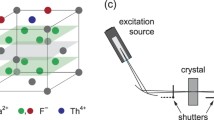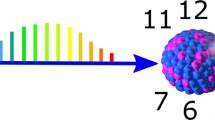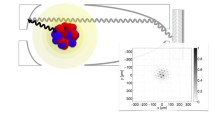Abstract
Among all the nuclei, Thorium-229 has the lowest excited level at approximately 8.3 eV. This level is an isomeric state with a long radiative lifetime. Therefore, \(\mathbf {^{229}}\)Th can be excited to the isomeric state using a vacuum ultraviolet laser and is expected to have applications such as in frequency standards. Our group has been conducting experiments to excite \(\mathbf {^{229}}\)Th to the isomeric state via the second excited state using the high-intensity X-ray beam available at the SPring-8 facility. To detect vacuum ultraviolet photons from the isomeric state of \(\mathbf {^{229}}\)Th, a dedicated apparatus was constructed. We employed \(\mathbf {^{229}}\)Th-doped CaF\(_2\) crystals as the irradiation target. Because these targets emit numerous scintillation photons due to nuclear decay and X-ray beam irradiation, detectors are required to significantly reduce these background events. To achieve this, we adopted dichroic mirrors and a photomultiplier tube for detecting scintillation photons by nuclear decay, in addition to a solar-blind photomultiplier tube for detecting decay photons from the isomeric state of \(\mathbf {^{229}}\)Th. In this proceedings paper, we describe the experimental apparatus used in the beamtime in 2023.





Similar content being viewed by others
Data Availability
No datasets were generated or analysed during the current study.
Notes
The Si(880) monochromator was installed in beamtime of 2023. This is found to be important for avoiding damage to the crystal target.
The typical X-ray beam intensity between the Si(660) and Si(880) monochromator is 9.5\(\times 10^{11}\) /s.
In terms of the reduction of the radioluminescence background events, a smaller crystal is better.
References
Peik, E., Tamm, C.: Nuclear laser spectroscopy of the 3.5 eV transition in Th-229. Euro. Phys. Lett. 61, 181 (2003). https://doi.org/10.1209/epl/i2003-00210-x
Campbell, C.J., Radnaev, A.G., Kuzmich, A., Dzuba, V.A., Flambaum, V.V., Derevianko, A.: Single-Ion nuclear clock for metrology at the 19th decimal place. Phys. Rev. Lett. 108, 120802 (2012). https://doi.org/10.1103/PhysRevLett.108.120802
Peik, E., Okhapkin, M.: Nuclear clocks based on resonant excitation of \(\gamma \)-transitions. C. R. Physique 16, 516–523 (2015). https://doi.org/10.1016/j.crhy.2015.02.007
Rellergert, W.G., DeMille, D., Greco, R.R., Hehlen, M.P., Torgerson, J.R., Hudson, E.R.: Constraining the evolution of the fundamental constants with a solid-state optical frequency reference based on the \(^{229}\)Th nucleus. Phys. Rev. Lett. 104, 200802 (2010). https://doi.org/10.1103/PhysRevLett.104.200802
Kazakov, G.A., Litvinov, A.N., Romanenko, V.I., Yatsenko, L.P., Romanenko, A.V., Schreitl, M., Winkler, G., Schumm, T.: Performance of a \(^{229}\)Thorium solid-state nuclear clock. New J. Phys. 14, 083019 (2012). https://doi.org/10.1088/1367-2630/14/8/083019
von der Wense, L., Seiferle, B.: The \(^{229}\)Th isomer: prospects for a nuclear optical clock. Eur. Phys. J. A 56, 277 (2020). https://doi.org/10.1140/epja/s10050-020-00263-0
Peik, E., Schumm, T., Safronova, M.S., Pálffy, A., Weitenberg, J., Thirolf, P.G.: Nuclear clocks for testing fundamental physics. Quantum Sci. Technol. 6, 034002 (2021). https://doi.org/10.1088/2058-9565/abe9c2
von der Wense, L., et al.: Direct detection of the \(^{229}\)Th nuclear clock transition. Nature 533, 47–51 (2016). https://doi.org/10.1038/nature17669
Seiferle, B., von der Wense, L., Thirolf, P.G.: Lifetime measurement of the \(^{229}\)Th nuclear isomer. Phys. Rev. Lett. 118, 042501 (2017). https://doi.org/10.1103/PhysRevLett.118.042501
Thielking, J., et al.: Laser spectroscopic characterization of the nuclear-clock isomer \(^{229{\rm m }}\)Th. Nature 556, 321–325 (2018). https://doi.org/10.1038/s41586-018-0011-8
Seiferle, B., et al.: Energy of the \(^{229}\)Th nuclear clock transition. Nature 573, 243–246 (2019). https://doi.org/10.1038/s41586-019-1533-4
Sikorsky, T., et al.: Measurement of the \(^{229}\)Th isomer energy with a magnetic microcalorimeter. Phys. Rev. Lett. 125, 142503 (2020). https://doi.org/10.1103/PhysRevLett.125.142503
Kraemer, S., et al.: Observation of the radiative decay of the \(^{229}\)Th nuclear clock isomer. Nature 617, 706–710 (2023). https://doi.org/10.1038/s41586-023-05894-z
Masuda, T., et al.: X-ray pumping of the \(^{229}\)Th nuclear clock isomer. Nature 573, 238–242 (2019). https://doi.org/10.1038/s41586-019-1542-3
Shigekawa, Y., et al.: Estimation of radiative half-life of \(^{229{\rm m }}\)Th by half-life measurement of other nuclear excited states in \(^{229}\)Th. Phys. Rev. C 104, 024306 (2021). https://doi.org/10.1103/PhysRevC.104.024306
Thirolf, P.G., Seiferle, B., von der Wense, L.: The 229-thorium isomer: doorway to the road from the atomic clock to the nuclear clock. J. Phys. B: At. Mol. Opt. Phys. 52, 203001 (2019). https://doi.org/10.1088/1361-6455/ab29b8
Beeks, K., Sikorsky, T., Schumm, T., Thielking, J., Okhapkin, M.V., Peik, E.: The thorium-229 low-energy isomer and the nuclear clock. Nat. Rev. Phys. 3, 238–248 (2021). https://doi.org/10.1038/s42254-021-00286-6
Tkalya, E.V.: Spontaneous emission probability for M1 transition in a dielectric medium: \(^{229{\rm m}}\)Th (3/2+, 3.5\(\pm \)1.0 eV) decay. JETP Lett. 71, 311–313 (2000). https://doi.org/10.1134/1.568349
Jeet, J., Schneider, C., Sullivan, S.T., Rellergert, W.G., Mirzadeh, S., Cassanho, A., Jenssen, H.P., Tkalya, E.V., Hudson, E.R.: Results of a direct search using synchrotron radiation for the low-energy \(^{229}\)Th nuclear isomeric transition. Phys. Rev. Lett. 114, 253001 (2015). https://doi.org/10.1103/PhysRevLett.114.253001
Yamaguchi, A., Kolbe, M., Kaser, H., Reichel, T., Gottwald, A., Peik, E.: Experimental search for the low-energy nuclear transition in \(^{229}\)Th with undulator radiation. New J. Phys. 17, 053053 (2015). https://doi.org/10.1088/1367-2630/17/5/053053
Stellmer, S., Kazakov, G., Schreitl, M., Kaser, H., Kolbe, M., Schumm, T.: Attempt to optically excite the nuclear isomer in \(^{229}\)Th. Phys. Rev. A 97, 062506 (2018). https://doi.org/10.1103/PhysRevA.97.062506
Dessovic, P., Mohn, P., Jackson, R.A., Winkler, G., Schreitl, M., Kazakov, G., Schumm, T.: \(^{229}\)Thorium-doped calcium fluoride for nuclear laser spectroscopy. J. Phys.: Condens. Matter 26, 105402 (2014). https://doi.org/10.1088/0953-8984/26/10/105402
Beeks, K., et al.: Growth and characterization of thorium-doped calcium fluoride single crystals. Sci. Rep. 13, 3897 (2023). https://doi.org/10.1038/s41598-023-31045-5
Masuda, T., et al.: Absolute X-ray energy measurement using a high-accuracy angle encoder. J. Synchrotron Radiat. 28, 111–119 (2021). https://doi.org/10.1107/S1600577520014526
Stellmer, S., Schreitl, M., Schumm, T.: Radioluminescence and photoluminescence of Th:CaF\(_2\) crystals. Sci. Rep. 5, 15580 (2015). https://doi.org/10.1038/srep15580
Acknowledgements
The synchrotron radiation experiments were performed at the BL19LXU line of SPring-8 with the approval of the Japan Synchrotron Radiation Research Institute (JASRI) and RIKEN. The author is grateful to the collaboration; Kjeld Beeks, Michael Bartokos, Hiroyuki Fujimoto, Yuta Fukunaga, Hiromitsu Haba, Yoshitaka Kasamatsu, Shinji Kitao, Adrian Leitner, Takahiko Masuda, Guan Ming, Nobumoto Nagasawa, Ryoichiro Ogake, Koichi Okai, Martin Pimon, Martin Pressler, Noboru Sasao, Fabian Schaden, Thorsten Schumm, Makoto Seto, Yudai Shigekawa, Koutaro Shimizu, Tomas Sikorsky, Kenji Tamasaku, Sayuri Takatori, Tsukasa Watanabe, Atsushi Yamaguchi, Yoshitaka Yoda, Akihiro Yoshimi, and Koji Yoshimura.
Funding
This work was supported by JSPS KAKENHI Grant Numbers JP19K14740 and JP21H01094 and Itoh Science Foundation for a grant.
Author information
Authors and Affiliations
Consortia
Contributions
T.H. and the collaboration members conducted the experiment. T.H. wrote the script and prepared the figures.
Corresponding author
Ethics declarations
Competing interests
The authors declare no competing interests.
Ethics approval
not applicable
Additional information
Publisher's Note
Springer Nature remains neutral with regard to jurisdictional claims in published maps and institutional affiliations.
Appendix A: Measurement of optical components
Appendix A: Measurement of optical components
For the estimation of the expected number of detected signal photons from \(^{229{\textrm{m}}}\)Th or \(\lambda _{\textrm{isomer}}\), we measured the transmittance or reflectance data of optical components, such as dichroic mirrors and VUV band-pass filters. Figure 6 shows a schematic view of the optical property measurement system. The monochromatic VUV light beam is generated using the deuterium lamp (Heraeus, D200VUV) and the spectrometer (Shinku-kogaku, VMK-200-II). Each sample is placed on motorized stages so that position and angle dependence can be measured. The PMT (Hamamatsu, R6836) is also mounted on another motorized rotation stage so that both transmittance and reflectance can be measured.
Rights and permissions
Springer Nature or its licensor (e.g. a society or other partner) holds exclusive rights to this article under a publishing agreement with the author(s) or other rightsholder(s); author self-archiving of the accepted manuscript version of this article is solely governed by the terms of such publishing agreement and applicable law.
About this article
Cite this article
Hiraki, T., on behalf of the collaboration. Experimental apparatus for detection of radiative decay of \(^{229}\)Th isomer from Th-doped CaF\(_2\). Hyperfine Interact 245, 14 (2024). https://doi.org/10.1007/s10751-024-01844-x
Accepted:
Published:
DOI: https://doi.org/10.1007/s10751-024-01844-x





